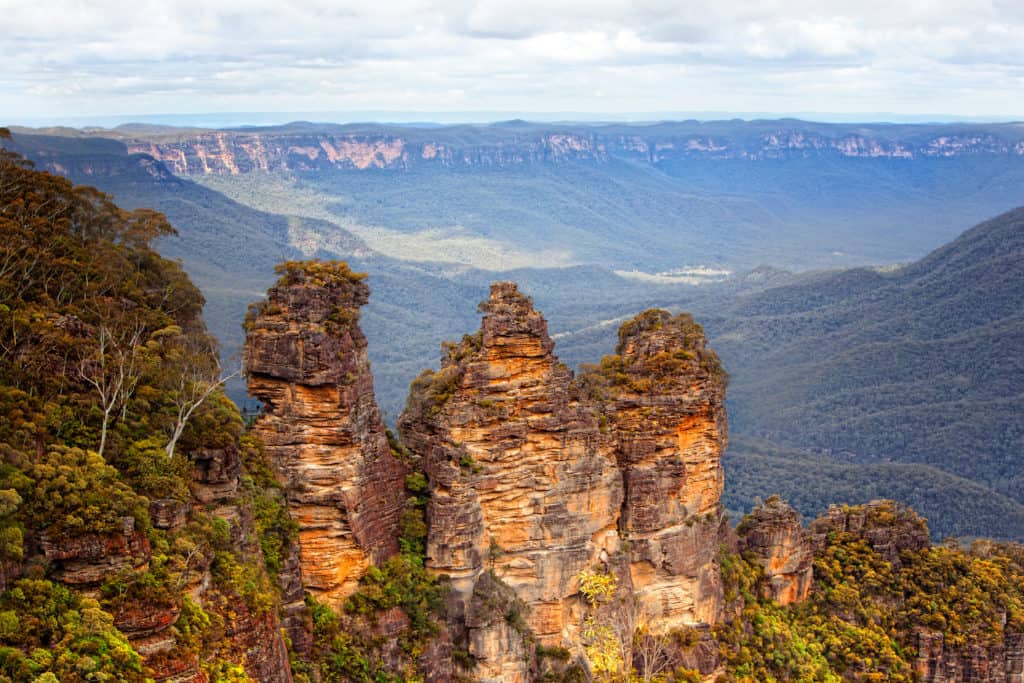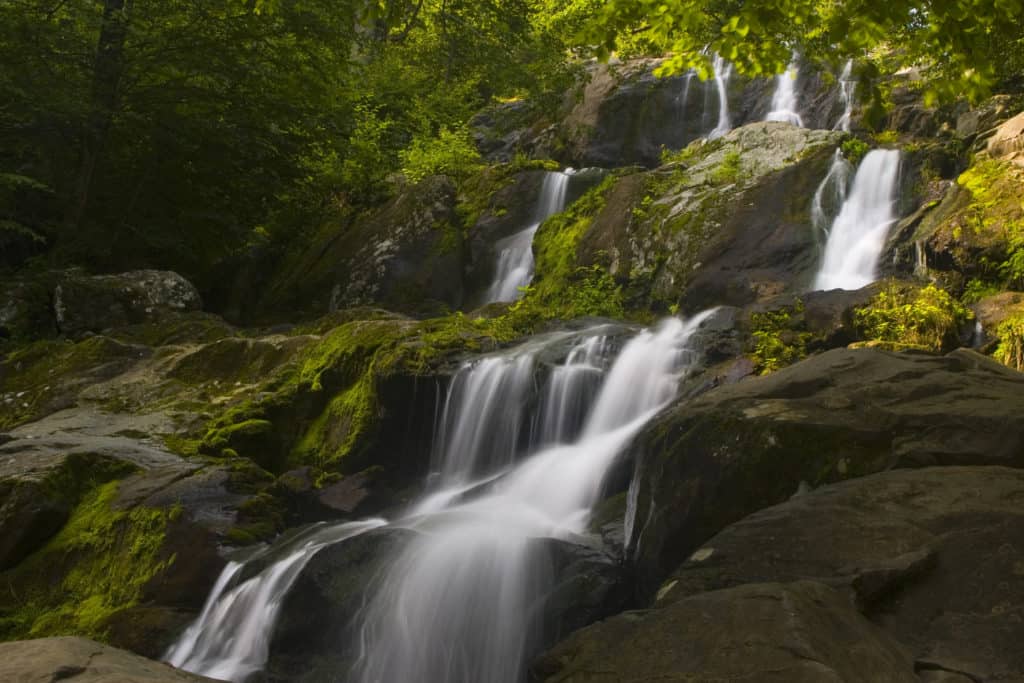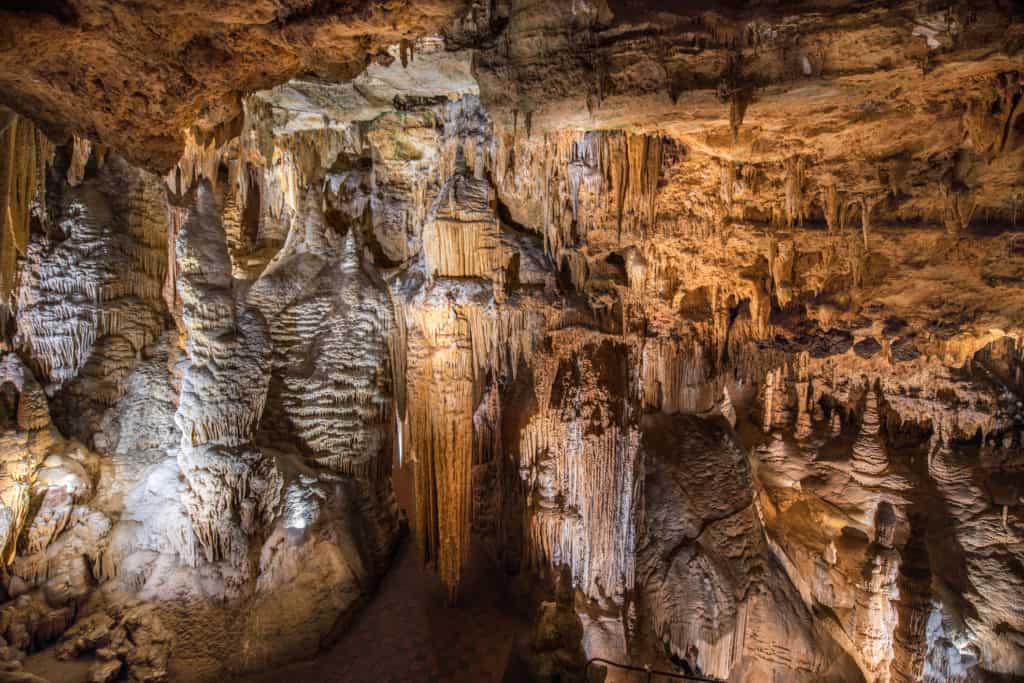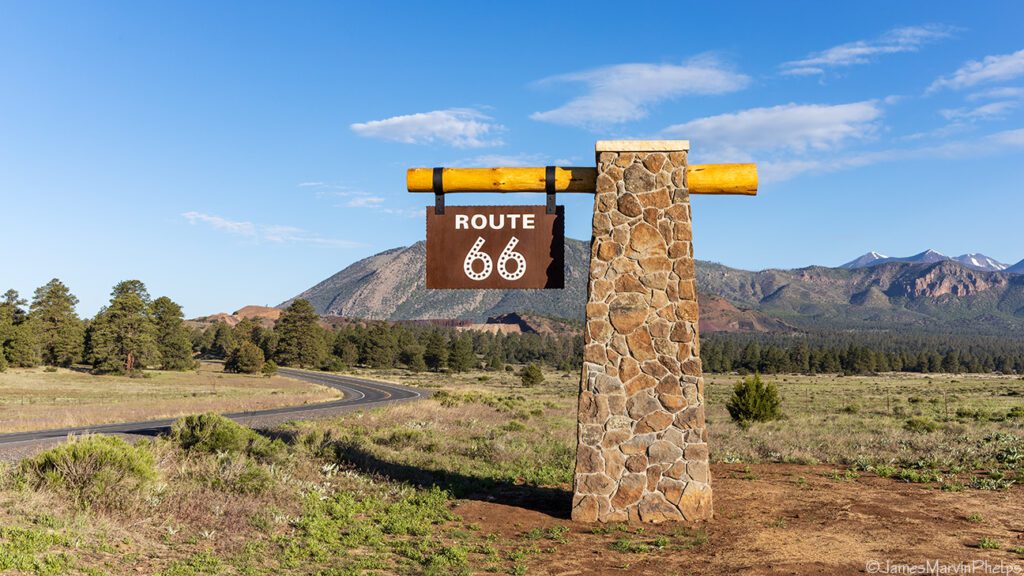There’s a long list of things to love about Virginia (is it any wonder that Virginia Tourism has used the “Virginia is for Lovers” slogan for over 50 years?) — and the amazing natural beauty of Shenandoah National Park, with its majestic mountains and boulders, towering forests, cascading waterfalls and tumbling streams tops that list.
Located in Luray, Virginia, just 75 miles from Washington, DC, the 200,000-acre park draws legions of visitors in every season. But without a doubt, autumn shows the marvels of this sanctuary to best effect. And one of the top ways to experience it is to drive the scenic Skyline Drive that runs 105 miles down the park’s length. Each elevation (the park rises from 550 feet to over 4,049 feet) manifests its own unique cloak of color. Seventy-five overlooks along the byway provide panoramic views encompassing everything from the Blue Ridge Mountains to the sprawling Shenandoah Valley.

The Skyline Drive
When driving the Skyline Drive, you’ll trace the crest of the Blue Ridge Mountains starting from Front Royal to Waynesboro, where it meets the Blue Ridge Parkway. You’ll not only take in stunning views but also experience tranquility while driving, partially because there are no commercial trucks to contend with on the byway. The north-to-south route connects the park’s major visitor centers, campgrounds, lodges, picnic areas and most trailheads. And you’ll always have a clear sense of where you are — concrete posts number every mile along the way. In good weather, you can cover the entire park in about three hours, traveling at the 35mph speed limit.
Top Overlooks & Things to Do Along Skyline Drive
Skyline Drive takes you through all three of the park’s designated wilderness areas: North District, Central District and South District.
North District
In the most northerly section of the drive, you’ll travel from the town of Front Royal to Thorton Gap, a distance of about 31.5 miles. Take in the views at historic Dickey Ridge Visitor Center (milepost 4.6); at Hogback Overlook (milepost 20.8), which is the longest overlook in the park, extending 0.2 miles along Skyline Drive; and at Thornton Hollow Overlook (milepost 27.6).
The Hogback Overlook provides a view of Gimlet Ridge, which descends into the valley below, and to the right of it, Mathews Arm. On a really clear day, you’ll be able to see the Allegheny Mountains in the distance. At Thornton Hollow Overlook, which is 2,460 ft. up, you’ll be able to see Thorton Hollow and mountains well into the distance, including Mount Marshall at the left of your view and Overtop Mountain to the right.
En route, at milepost 22.1, you can walk to Piney River Falls — the hike is particularly picturesque in the fall. You’ll be taking the shady Piney Branch Trail through a pristine forest of basswood, yellow birch and red maple to the 25-foot waterfall, which cascades over moss-covered rocks into a deep pool. The 6.8-mile hike is only moderately difficult and will only take a few hours.
To overnight during this leg of your drive, head to the Matthews Arm Campground (milepost 22.2), which has 165 camp sites — you can connect with many hiking trails right from the campground (advance reservations are recommended; book here). And there’s a picnic area (milepost 24) that will let you refuel amidst the trees.
Central District
Along the central portion of the route, you’ll go from Thorton Gap to Swift Run Gap, a distance of 34 miles. This is a breathtaking drive encompassing what are arguably the best views in Shenandoah National Park, the highest point on Skyline Drive, two visitor centers, two lodges, two campgrounds and several historic cabins. You’ll likely want to access those superlative views both from the road and deeper in, on the trails.
At the Meadow Spring parking area (milepost 33.5), hike to Mary’s Rock and take in uninterrupted 360-degree views from the large outcrop. At the stony summit, you’ll be 3,750 feet up. Looking northward from the outcrop, you can see many Blue Ridge peaks and, to the west, the town of Luray and the Shenandoah Valley. Understandably, many folks regard this spot as their favorite vantage point in the whole park.
At Pinnacles Overlook (milepost 35.1) you can see a lot of beauty from the car and access a picnic area nearby. A great spot to spend the night is Skyland Lodge (milepost 41.7), located at Skyline Drive’s highest elevation across 27 acres of the park. From there, it’s an easy hike on Stony Man Trail to Stony Man, the highest spot on the Appalachian Trail within the park—the vistas along the ridge are spectacular and the rock outcrops of Little Stony Man, just below the main peak, form sheer cliffs. (The rock outcrops in Shenandoah National Park are among its most notable features—they’re extremely large and are peppered with rare plants and animals.)

History buffs will find Rapidan Camp fascinating — it’s the site of the first presidential retreat; Herbert Hoover fished here for trout and hosted world leaders. You can get to it from Milam Gap (milepost 52.8) and see Big Rock Falls on the way. For those who enjoy scrambling over boulders, Bearfence Mountain Rock Scramble (milepost 56.4) is super fun — and the views are terrific, too! Lewis Mountain Campground (milepost 57.5) is a serene spot to spend the night in the Central District, but don’t leave the area without a stop at 83-foot South River Falls, accessible from the South River Picnic Area (milepost 62.8).
To experience another lofty spot — the park’s highest peak at 4,051 feet — head to Hawksbill from milepost 46.7; the embedded directional indicator will clue you in to the mind-blowing sights available to you from this dramatic perch. Afterwards, drive to Big Meadows (milepost 51); you may just see some deer. The visitor center here is a great place to learn more about park and plot additional adventures. If you like, you can spend the night at the highly popular Big Meadows Campground, which has 221 sites (advance reservations are recommended; book here). And you can readily hike to nearby waterfalls from the Big Meadows area. The hike to Dark Hollow Falls, which tumbles 70 feet over greenstone (the waterfall that’s closest to Skyline Drive) is quite popular. Access the trailhead at the Dark Hollow Falls Parking Area (milepost 50.7) and descend a quarter of a mile down to the falls along a stream. You’ll be hiking for about an hour and 15 minutes; the trail is moderately difficult. Also try to see 81-feet-tall Lewis Spring Falls and 67-foot Rose River Falls.
South District
Proceeding from Swift Run Gap to Rockfish Gap for a distance of 40 miles, the southern section of Skyline Drive is the longest and quietest part of the road trip, and it’s brimming with untamed wilderness and exposed geology, from elaborate rock formations, boulder fields (aka talus slopes) and outcrops to rugged trails in the Big Run area and scenic watery destinations like Doyles River and Moormans River.
The two best overlooks in the South District are the Rocky Mount Overlook (milepost 71.2) with views of Rocky Mount, Two Mile Ridge and Massanutten Mountain, and Rockytop Overlook (milepost 78.1), which faces Lewis Mountain in the far distance and Loft Mountain on the right.
If you need some relief from the wilds, Loft Mountain (milepost 79.5) is the place to go; there’s a camp store there as well as the park’s biggest campground. Or, you can enjoy a picnic at the Dundo Picnic Grounds.
At milepost 83, you can go on a 6.5-mile loop hike from Browns Gap and see three huge waterfalls — a couple on Doyles River and a third, 42-ft. fall, on Jones Run. Another water highlight that’s accessible from Browns Gap: the translucent pools of Big Run, a very large stream (on hot days, take a dip to cool off). Finally, take the 3.4-mile circuit walk from the Riprap Parking Area (mile 90) to Chimney Rock — you’ll find the experience of sitting on the rocks and looking out over the gorge below a fitting end to your amazing Skyline Drive trip.
Other Things to See & Do in the Area
Luray Caverns
These subterranean caverns, filled with some of the most spectacularly delicate and intricate natural formations you’ll ever see, are the largest in the eastern U.S. and a designated U.S. Natural Landmark. Be sure to visit when you’re in Luray — you’ll be blown away by the scale of Giant’s Hall, the largest ‘room’ in the caverns, which features 10-story-tall gold-toned columns that took shape over eons as a crystalline form of limestone dripped down and iron and clay seeped from the ground. Other mind-blowing formations you’ll see at the caverns: the golden Empress Column, in which a stalactite and stalagmite meet; Frozen Mountain, a gigantic, rounded white flowstone; and pure white Titania’s Veil, shaped by calcite drips. You’ll also find the world’s largest musical instrument in The Cathedral ‘room’ here — The Great Stalacpipe Organ, a custom instrument whose pipes are stalactites of various sizes with small rubber mallets. Have a listen to the glorious sounds they produce.
Tip: Bring a jacket—it’s a constant 60 degrees below ground.

The Garden Maze at Luray Caverns
Also visit the maze at Luray Caverns — at one acre, it’s one of the largest hedge mazes in the Mid-Atlantic region. The confounding pathway is formed with more than 1500 Dark American Arborvitae and diverges at more than 40 points; it’ll be on you to choose a direction as you reach them. Good luck navigating the many twists and turns as you search for hidden goals.
Luray Singing Tower
At this tower, which contains a carillon of 47 bells, you can listen to free recitals played by the staff carillonneur and guest musicians—everything from patriotic, folk and classical music to hymns and popular melodies.
Luray Zoo
If you have kids in tow, head to this privately owned 3-acre rescue zoo with more than 80 indoor exhibits featuring reptiles. Outside, more than 20 exhibits showcase primates, feline, birds and mammals. In the petting zoo section, you can feed and pet goats, emus, sheep and wallaby.






